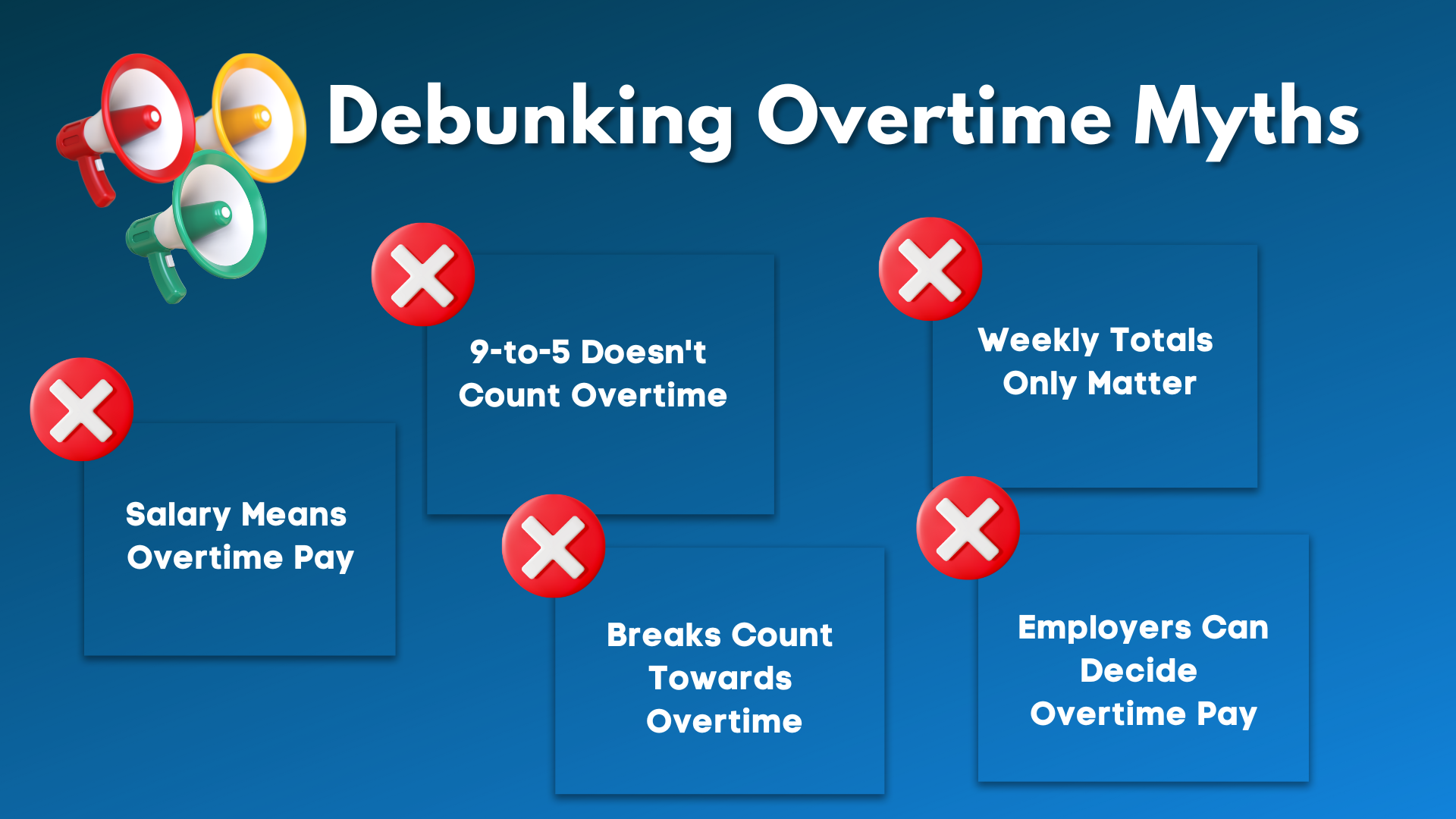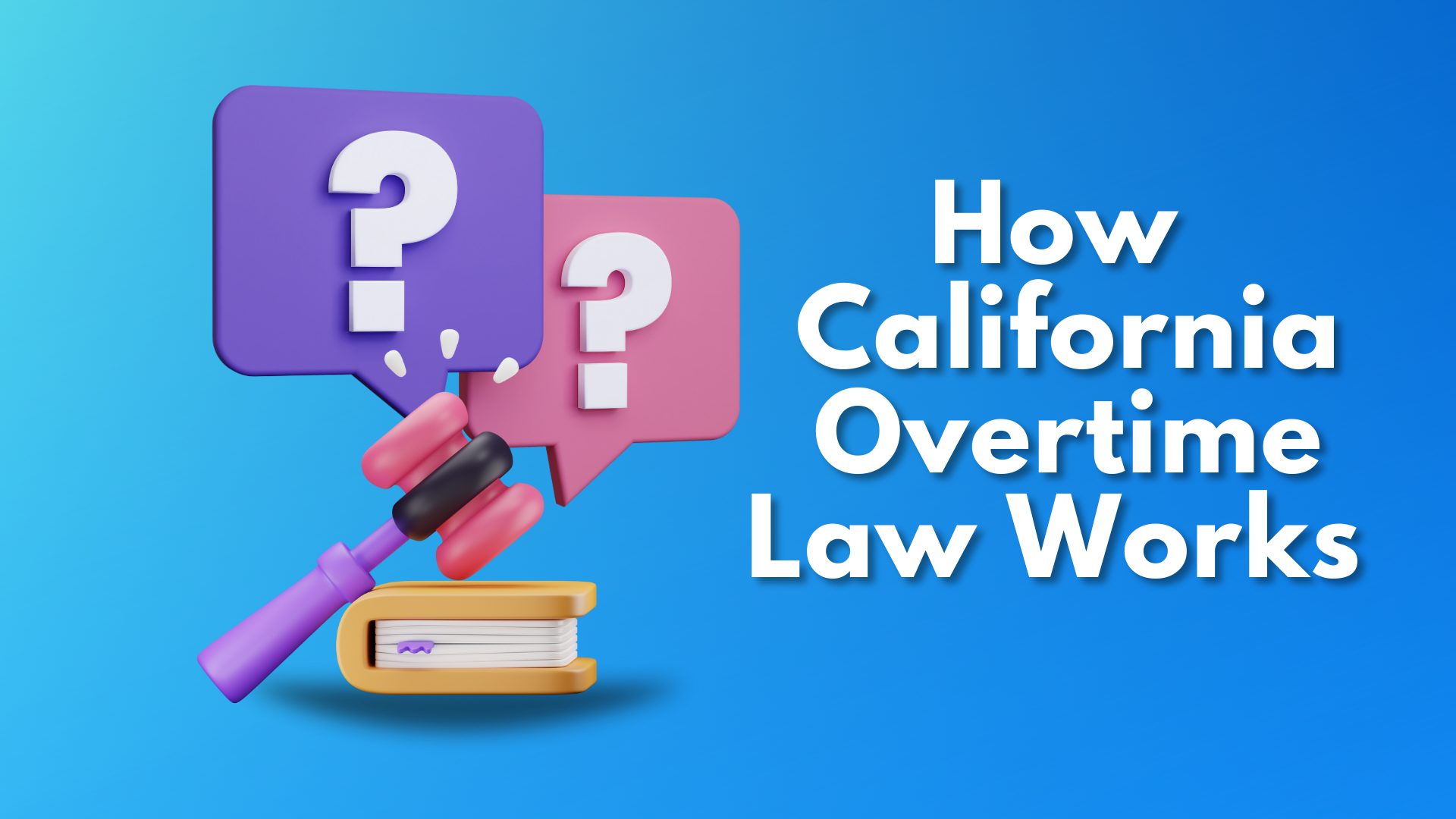How to Prevent Paycheck Blues with California Overtime Law
Understanding rights and obligations under California's overtime pay law is crucial for preventing paycheck blues. Learn about the regulations and protections in place to ensure fair compensation for overtime work.

The California Overtime Law dictates how overtime pay is calculated and distributed to employees in the state.
Understanding California's overtime laws can feel like navigating a legal maze, – yet it is crucial:
- for employees to prevent confusion about paychecks
- for employers to stay compliant with overtime rules.
To start, we are debunking the most common overtime myths to get employees clear on their rights.
Busting Overtime Myths: What California Workers (Remote or Otherwise) Need to Know

Myth #1: Salary Means No Overtime Pay
Just because you receive a salary doesn't automatically disqualify you from overtime. Only exempt employees, like high-level executives or certain computer professionals, are excluded. Most salaried workers in California are non-exempt and entitled to overtime after 8 hours in a day or 40 in a week.
Myth #2: 9-to-5 Doesn't Count Overtime
California doesn't follow a strict 9-to-5 rule. Any hours over 8 in a day qualify for overtime, regardless of your daily schedule. Remember, that includes remote work! Just because you're outside the office doesn't change your eligibility.
Myth #3: Weekly Totals Only Matter
Overtime is calculated daily and weekly. So, even if you stay under 40 hours per week, exceeding 8 hours in a single day triggers overtime pay for those extra hours.
Myth #4: Breaks Count Towards Overtime
Meal breaks exceeding 30 minutes typically don't count as work time. However, short coffee breaks or working through lunch do factor into your overtime calculations.
Myth #5: Employers Can Decide Overtime Pay
California law dictates overtime rates. For the first 8 overtime hours, they are 1.5 times your regular hourly rate, and for the rest, they are double time. Employers can't offer compensatory time off in lieu of overtime pay unless you explicitly agree.
As of 2023, businesses with 26 or more employees, including those in the agricultural sector, are subject to this rule.
The Bottom Line: The California Overtime Law is a key defender of workers' rights, guaranteeing that employees are fairly compensated for putting in extra hours beyond the usual workweek.
It works hand in hand with the California Transparent Salary Law, which champions job fairness by making salary information open and accessible.
Together, these laws create a strong safety net, ensuring that hard work pays off and that every extra hour is recognized and rewarded, showcasing a deep commitment to just and equitable work conditions.
How Does California Overtime Law Work?

Imagine Sarah, a dedicated barista, consistently works 10-hour shifts to cover busy timeslots.
While she loves her job, the extra hours leave her drained and unsure if she's being fairly compensated.
This scenario, sadly, isn't uncommon. Many workers, like Sarah, face uncertainty about overtime pay while employers grapple with ensuring compliance.
Understanding California's Overtime Law can be helpful, as it is known for its employee-friendly stance and provides important protections for workers.
So, let's delve into the details!
California vs. FLSA

California takes a stricter stance on overtime than the federal Fair Labor Standards Act (FLSA).
Here's the breakdown.
- California: Overtime kicks in after 8 hours a day and 40 hours a week (and even on the 7th consecutive workday).
- FLSA: Overtime starts after 40 hours a week only.
The Bottom Line: Unlike the more lenient federal Fair Labor Standards Act (FLSA), which requires overtime pay only after 40 hours a week, California's law is designed to offer greater protection to workers.
Who Gets the Overtime Prize?
Not everyone qualifies for overtime pay. The key lies in understanding exempt vs. non-exempt status.
Generally, executives, supervisors, and some computer professionals are exempt. But most hourly and salaried workers fall under the non-exempt category, meaning they're entitled to overtime pay.
Calculating Overtime Earnings
Confused about how much overtime you're owed? Don't worry. It's not rocket science!
The formula is: (Regular Pay Rate x 1.5) x Overtime Hours.
Let's say your regular hourly rate is $20, and you work 9 hours on a weekday. Your overtime pay would be (20 x 1.5) x 1 = $30.
This formula reflects the law's intent to fairly reward extended work commitments.
Double Time Pay - Work Long, Get Rewarded (Twice!)
In California, employees are entitled to double-time pay, a sweet perk for exceeding specific work limits.
Here's how it works:
- 12-Hour Rule⏱️ Clocking in for more than 12 hours in a single day triggers double time for all hours worked beyond 12. Whether you're a night owl finishing a project or a first responder going the extra mile, your hard work gets double the compensation.
- 7th Day Blues? Not Exactly⏱️ Working the 7th consecutive workday means earning double time for any hours exceeding 8 hours. So, those weekend shifts or extended projects earn double the regular rate, making up for the lost rest and leisure time.
This is on top of employees' regular hourly pay. So, if the regular rate is $20, double time means that respective categories of employees earn $40 per hour for those qualifying hours.
Overtime Calculation with Multiple Rates of Pay

In California, when an employee earns different hourly rates within the same workweek, calculating their overtime pay gets a bit trickier.
The Rule: California law requires overtime pay to be calculated based on a weighted average rate, not just base pay. How is this calculated?
- Identify Rates and Hours: Start by listing all the different hourly rates the employee earned during the week, along with the corresponding hours worked at each rate.
- Calculate Regular Hours: Determine the number of hours worked at the regular rate (usually 40 hours, but it could be less if they started mid-week).
- Calculate Total Wages: Add up the earnings from all rates worked (total hours at each rate multiplied by their respective rates).
- Weighted Average Rate: Divide the total wages by the total hours worked across all rates to get the weighted average rate.
- Overtime Rate: Multiply the weighted average rate by 1.5 (for time-and-a-half) or 2 (for double time, applicable in certain scenarios).
- Overtime Hours: Calculate the number of overtime hours worked (all hours exceeding 40 or 8 per day, whichever comes first).
- Overtime Pay: Multiply the overtime hours by the overtime rate you calculated in step 5.
For instance, an employee works the following hours and rates in a week:
- 20 hours at $15/hour
- 15 hours at $20/hour
- 5 hours at $25/hour
Their total overtime pay would be calculated as follows:
- Total wages (20 * $15) + (15 * $20) + (5 * $25) = $650
- Total hours 20 + 15 + 5 = 40 hours
- Weighted average rate $650 / 40 hours = $16.25/hour
- Overtime rate $16.25/hour * 1.5 = $24.38/hour (assuming time-and-a-half)
- Overtime hours 8 hours (since they worked 40 hours total and the regular workweek is 40 hours)
- Overtime pay 8 hours * $24.38/hour = $195.04
This is a simplified example, and specific situations might require additional considerations. Consulting with an employment law expert is recommended for complex scenarios or legal guidance.
Alternative Workweek Schedules in California
In California, employers can offer alternative workweek schedules (AWS), which enable employees to work longer daily hours but within a 40-hour workweek, potentially avoiding overtime pay.
However, implementing such schedules requires strict adherence to specific regulations.
- Employee Consent: A two-thirds majority vote of the affected employees within the work unit, conducted through a secret ballot, is mandatory for adopting an AWS.
- Schedule Restrictions: The workweek must consist of shifts exceeding 8 hours per day but cannot exceed 10 hours daily and must total 40 hours per week.
- Overtime Rules: For employees on an AWS, overtime pay applies differently (Daily: They earn time-and-a-half for hours exceeding their scheduled daily shift (up to 12 hours) or 40 hours total that week. Weekly: Time-and-a-half still applies for any hours exceeding 40 in the workweek).
The Bottom Line: Implementing an AWS can be complex and legally sensitive. Seeking legal counsel is highly recommended. This option might not be suitable for all employers or work environments due to scheduling limitations and potential employee preference variations.
Employers, Take Heed: Compliance is Key!

It's worth considering that employees cannot waive their right to overtime pay. Agreements that attempt to waive overtime rights are deemed void and unenforceable.
Employers who fail to pay overtime as required by California law may face penalties, including paying the unpaid overtime owed to the employee, interest on the unpaid wages, and civil penalties.
Ensuring proper overtime pay involves:
- Accurate record-keeping ⌛Track employee work time meticulously
- Transparency💡 Clearly communicate overtime policies to your team.
- Conformity✍🏻 Stay updated on any changes to overtime laws.
Employees, Empower Yourself!
Empowerment comes from knowledge. California is leading the way in prioritizing employee wellness by becoming the first state to officially recognize the "right to disconnect" from online communications outside of regular business hours.
This is a critical step towards protecting employees' mental health while encouraging more sustainable work habits.
To understand the legal framework for overtime salary, employees should familiarize themselves with their rights to fair overtime pay and the mechanisms for recourse if those rights are infringed upon, such as filing a complaint with the California Labor Commissioner's Office.
The California Department of Industrial Relations promotes language accessibility by helping people who speak languages other than English get the needed services.
Awareness and advocacy for one's rights are crucial steps in guaranteeing fair treatment in the workplace.
Concluding Thought
Seeming intricacies of California overtime laws are more than legal jargon; they are a cornerstone of fair employment practices.
Understanding California overtime laws benefits everyone.
For workers like Sarah, awareness of this law translates into empowerment and assurance of rightful compensation.
Employers, on the other hand, stand to gain from diligent compliance, as it mitigates legal risks and cultivates a culture of transparency and respect in the workplace.
In this ecosystem, the law bridges labor rights and business obligations, fostering a fair and equitable work environment.
What Is California Overtime Law?
California overtime kicks in for most employees after 8 hours/day or 40 hours/week.
You earn 1.5 times your regular pay for exceeding those limits, including the first 8 hours on your 7th workday.
This applies to businesses with 26+ employees, including agriculture since 2023.
Remember, some salaried workers are exempt.

